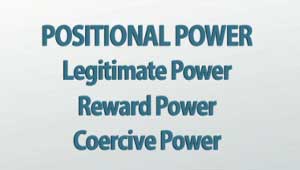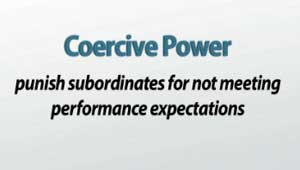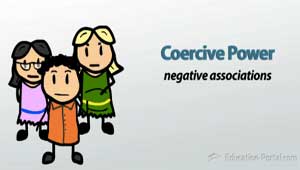Positional Power: Legitimate, Coercive & Reward Power - Answers
The answers are in BOLD below.
NOTE: The transcript from the video is listed below the quiz for your reference.
1. Which type of power is the result of the manager's position within the organization and includes the power bases of legitimate power, reward power and coercive power?
- personal
- positional
- personality
- organizational
- acquired
2. Which of these power bases is used to punish subordinates for not meeting performance expectations?
- legitimate
- coercive
- expert
- referent
- reward
3. Which of these power bases stems from the manager's position in the organization and the authority that lies in that position?
- legitimate
- coercive
- expert
- referent
- reward
4. Which of these power bases reflects the extent to which a manager can use rewards to influence others?
- legitimate
- coercive
- expert
- referent
- reward
5. Which of these power bases is considered the opposite of coercive power?
- legitimate
- coercive
- expert
- referent
- reward
Managers require different types of power to make things happen in their organizations. This lesson focuses on positional power. There are three types of positional power that will be explained in this lesson, including legitimate, reward and coercive power.
Managerial Power
Managers require power to make things happen in their organizations. Power can be defined as a manager's ability to influence others. Influence is what managers have when they use power in such a way that it results in some behavioral response in others. Effective managers understand how to use their power to influence organizational members to act according to their wishes and to put into place processes and procedures that work toward organizational goals. A manager obtains his or her power from both the organization (positional power) and from him or herself (personal power). The key to successful management lies in using a combination of positional power and personal power. This lesson will discuss the first of these: positional power.
Positional Power
The most commonly recognized form of power that a manager has is positional power. Positional power is a result of a manager's position within the organization. The three main bases of positional power include legitimate power, reward power and coercive power.
 |
Reward power is the extent to which a manager can use rewards to influence others. Managers have power to reward subordinates for their actions when those behaviors meet or exceed performance expectations. Examples of such rewards include pay increases or bonuses, promotions, more responsibility and autonomy, as well as recognition and praise. For example, when Kelly exceeds her sales quota for the first quarter of the organization's fiscal year, her manager Jack rewards her with a bonus check for $500 and sends out an e-mail to her coworkers acknowledging the good job Kelly has done.
 |
 |
Examples of coercive power include things such as reprimanding or criticizing a subordinate; writing up, demoting or firing an employee; withholding pay increases or lowering an employee's salary and denying a reward. The manager may only have enough coercive power to recommend these sanctions to someone else who has the authority to carry them out, but nevertheless, the very threat of punishment is usually enough to influence employee behavior. For example, Jill is a coworker of Kelly who, unlike Kelly, failed to meet her sales quota last quarter. Jack is fed up with Jill's inability to make sales and wants her to be transferred to another team or even fired. However, Jack does not have this authority. He does have the power to recommend Jill's transfer and/or termination to his boss, who has the authority to carry out the sanction.
It is important to note that subordinates respond differently to the three types of positional power.
 |
 |
Lesson Summary
Let's review. Managers require power to make things happen in their organizations. Power can be defined as a manager's ability to influence others. A manager obtains his or her power from both the organization (positional power) and from him or herself (personal power). The key to successful management lies in using a combination of positional power and personal power. This lesson focused on the first type of power, known as positional power.
Positional power is a result of a manager's position within the organization. The three main bases of positional power include legitimate power, reward power and coercive power. Legitimate power stems from the manager's position in the organization and the authority that lies in that position. Subordinates acknowledge the legitimate power that comes from being in a leadership position in an organization. Reward power is the extent to which a manager can use rewards to influence others. Managers have the power to reward subordinates for their actions when those behaviors meet or exceed performance expectations. Coercive power is the opposite of reward power and is used by managers to punish subordinates for not meeting performance expectations or to deter subordinates from making decisions that will negatively affect the organization.